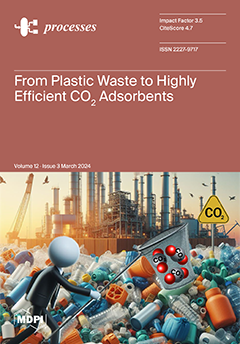Pectinase, a kind of hydrolase, mainly contains polygalacturonase, pectinase, and pectin lyase, which can hydrolyze pectin to generate galacturonide and is widely used in industry. At present, pectinase’s activity is still relatively low. Hyperactive pectinase was produced with solid-phase fermentation and a tray
[...] Read more.
Pectinase, a kind of hydrolase, mainly contains polygalacturonase, pectinase, and pectin lyase, which can hydrolyze pectin to generate galacturonide and is widely used in industry. At present, pectinase’s activity is still relatively low. Hyperactive pectinase was produced with solid-phase fermentation and a tray bioreactor using the novel strain
Aspergillus sp. CM96 in this study. This pectinase’s activity can reach 17,000 U·g
−1 after fermentation with a tray bioreactor, an increase of 86% compared to that obtained using flask liquid fermentation. The pectinase was purified and its characteristics were explored. Additionally, during pectinase fermentation, the activities of protease, glucanase, and cellulase were also determined to reach 7000, 8000, and 3000 U·g
−1. The enzyme mixture was used to improve substrate digestion efficiency in 144 Soviet white pigs after adding a 0.05% cocktail enzyme for 38 days. The results showed that the average daily gain (ADG) increased by 139.41 ± 1.04 g·day
−1, while the average daily feed intake (ADFI) and the feed conversion rate (FCR) decreased by 19.82 ± 1.64 g·day
−1 and 0.07 ± 0.01 in 38 days, which indicated that the addition of hyperactive pectinase from the strain CM96 can increase nutrient digestibility and improve feed efficiency.
Full article





